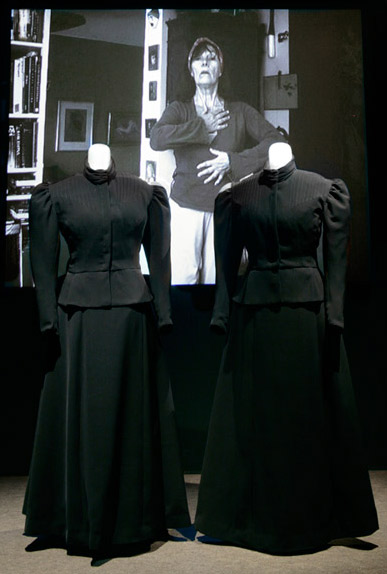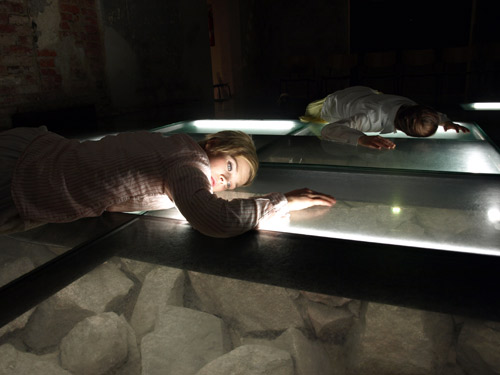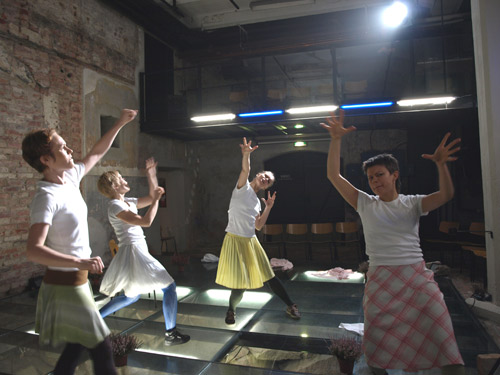Freeing Finnish Women’s Voices
The Work of Artist and Choreographer Maija Hirvanen
Finland became the first country in Europe to grant women the right to vote in 1906, and the first country in the world where women could run for office. In 2000, Finns elected their first female president, Tarja Halonen, who won a second term in 2006.
Although substantial progress has been made, the roles of Finnish women--in the political, professional, and social spheres--continue to evolve. Artist and choreographer Maija Hirvanen explores the challenges women in Finland still face today.

Two black, old-fashioned dresses stand side by side in front of an instructional film. As the film teaches the movements of gymnastics, a voice recites the words "sound, voice, speak, speak up, vote" in different languages.
The dresses are reproductions of those worn by Finland's first women members of parliament. The installation is called "From a Woman's Mouth," and was featured in the 2006 exhibition "Winning the Vote" that celebrated Finnish women's suffrage centennial.
31-year-old artist and choreographer Maija Hirvanen juxtaposes these historical symbols of political and social female life, highlighting a relationship which has been manipulated both in favor of and against women's voting and electoral rights.
Identity also figures strongly in another of Hirvanen's works, a 2007 dance performance entitled "Yeah Yeah Yeah and Other Words," which explores the importance of voting and freedom of expression, and the strong sense of self necessary for women to feel comfortable making their voices heard.
As Hirvanen explains, "The body functions in the piece as not only a representation of freedom of speech, but also the path through which the freedom of speech itself is possessed."
What would you say are the most important concerns for women in Finland, today?
The women in my generation are struggling with balancing professional life and family life. The role of women in families changed a lot within the generation jump from my grandmother to my mother (who was born right after the second world war and Finland's latest war with Russia) and from my mother's generation to my own. The women in my generation devote much more to the development of their professional lives, but often have the family to take care of, too. This is a practical challenge, a power challenge, a challenge related to identity.
Why did you choose installation and dance as a means to explore the issues of women's suffrage and freedom of speech?
In performance art, the concept of "personal as political" has played a significant role in both in feminist performance art and the art form in general. In the time of the suffragettes, the issues thought to concern women in politics were related to childcare, the work life, and the practicalities of poverty--the realm of the personal. In today's political system, this is still partly the assumption and but is also true on an everyday level. In "From a Woman's Mouth" I tried to combine fragments of the personal and the time before suffrage to convey a voice of the female gender rising up.
What does the right to vote mean to you?
Voting is both my freedom and duty as a citizen, person, and artist. My generation is often thought to be less political than the previous ones in the sense of being involved in party politics. There has been a shift in how political issues are dealt with and acted upon. I consider voting to be an ongoing process which culminates at the time of an election. During the election time, voting consists of the action of giving one's vote, but before and after that it also includes conversations, debates, reading, and testing one's opinions. So by voting, we're not only doing our part to guide the political world, but developing our communities and ourselves by opening our minds to different ways of thinking.
Describe how the movements of the dancers in "Yeah Yeah Yeah and Other Words" explore the importance of freedom of speech for women.
In the beginning of the piece, the movements are stagnant and robotic; mechanical. The performers don't speak a word. During the performance, through a careful building up, the women start to gain power and relaxation in their movements, and at the same time, start finding their voice. Through first making their breath more powerful, and the sounds of their movement louder, then singing constant tones of sound into the space, they gradually end up giving speeches about their opinions to the audiences. The speeches include personal and political opinions. The movements of the dancers follow through a similar development: from the stuck feeling in the beginning, they first march, then run around in the space and throw themselves into wilder movements, then wrestle playfully and finally converge to speak their minds. In the end, the women jam freely on the dance floor, rhyming their political opinions out loud to a pop music beat.
Finland currently has its first female president. Do you think this has changed the political climate of the country? How do you feel about political opportunities for women in Finland?
In the beginning, participation in government was not easy for women; for the first women in parliament it was a challenge to make their opinions heard. The role of women in parliament was mostly limited to the issues surrounding social and family concerns. This was of course in relation to the whole construction of society from the gender perspective; home was the kingdom of women. The election of Tarja Halonen is naturally a very significant point in history, but there are many other important political posts still historically uninhabited by women in Finland--history has yet to be made.
We have free education in Finland as well as a social welfare system that supports mothers and families financially, and these factors make political opportunities for women much more available than in many parts of the world. There are other challenges though, like cultural values that encourage males more than females to hold positions of power. It is said that Finland is one of the best examples of the merits of social democracy. Today our challenge is to maintain and develop those merits.
Finnish Choreographer Maija Hirvanen is currently preparing to premier a choreographed performance entitled "BLINK," which explores the first impressions that can make an impact in the blink of an eye. She's also working as conceptual designer and coordinator on a multimedia performance piece, "Edge of Europe," in collaboration with the Kiasma Museum of Contemporary Art in Helsinki. She continues to explore "From a Woman's Mouth" in lectures and performances.



